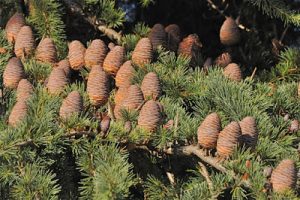Grand Fir
The grand fir tree is a medium to large fir tree found in North America. It was first described by a Scottish botanist, David Douglas, who has also lent his name to the Douglas fir. Its main adaptation is the fact that it can grow in various kinds of soils.
Scientific Classification
| Kingdom | Plantae |
| Division | Pinophyta |
| Class | Pinopsida |
| Order | Pinales |
| Family | Pinaceae |
| Genus | Abies |
| Scientific Name | Abies grandis |
Quick Information
| Other Names | Giant fir, lowland white fir, great silver fir, Vancouver fir, western white fir, Oregon fir, silver fir, yellow fir, stinking fir, Puget Sound fir, sapin grandissime (French), abeto grande (Spanish) |
| Identification | Size: Up to 262 ft (80 m) at maturity Trunk Diameter: 6.6 ft (2 m) Leaves (Needles): Flattened, 0.75-2 in (1.9-5 cm) long, topside dark yellow-green with two white bands, notched or rounded apex, arranged spirally, arranged in 2 ranks towards the crown alternating on the twig, perpendicular to the shoot and parallel to each other Fruits (Cones): 2-4 inches (5-10 cm) in length, barrel-shaped, purplish green to green at maturity Bark: Grayish-green with resin-blisters when young, eventually becomes 2-3 in (5-7.6 cm) thick at maturity, patchy and grayish-brown, flattened ridged wrinkles, purple-red inner bark |
| Tree Type | Evergreen |
| Varieties |
|
| Distribution/Range | British Columbia in Canada, Washington, Oregon, Montana, Idaho and California in the USA |
| Habitat | Moist coniferous forests at altitudes from sea level to 5,906 ft (1,800 m) |
| Hardiness Zones | 5-6 |
| Growth Rate | Slower in shades, aggressive in the open; annual growth is up to 1.5 m (4.9 ft) when young |
| Lifespan | 250 years; occasionally over 300 years |
| Growing Conditions | Winter Conditions: Tolerant of winter temperatures down to -100°F (-73°C) Summer Conditions: Cool to moderate weathers during the summer Rainfall: 25 in (63.5 cm) per year Soil: Neutral to acidic Light Requirement: Full Sun |
| Needle Retention | Fragile |
| Diseases & Pests | Fir engraver beetles, root diseases |
| Breeding (Reproduction) System | Monoecious |
| Propagation | By seeds |
| Seed Dispersal | Scales deciduous as seeds ripen |
| Seedling Development | Germination is relatively easy |
| Wildlife Value | Livestock use it as shade; moose, deer, and blue, sharp-tailed and ruffed grouse eat the needles in winter; nuthatches, chickadees, squirrels and other rodents eat the seeds |
| Uses | As an ornamental tree, Christmas trees; softwood lumber used in making paper, construction of floors and frames; also used as a medicine for treating fevers and colds |
| IUCN Conservation Status | Least Concern |
Comparison of Grand Fir with other Fir Species
Grand fir vs. Douglas fir
Needles on the grand fir are dark yellow-green on top whereas Douglas fir needles are green.
Grand fir vs. Balsam fir
Grand fir grows in the Pacific Northwest and California while the Balsam fir inhabits Northeastern United States.
Grand fir vs. Fraser fir
Fraser fir needles have a silvery appearance while grand fir needles don’t.
Grand fir vs. Pacific silver fir
Grand fir grows in moist coniferous forest and Pacific silver fir grows in the temperate rainforests.
Interesting Facts
- In the North American lumberjack circles, the grand fir is also known as the ‘hem fir’, which is an umbrella term coined to refer to the noble fir, California red fir, Pacific silver fir, western hemlock fir and the white fir (Abies concolor).
- The scent of the grand fir is citrus like, thus adding to its popularity as a Christmas tree.
References
- https://www.iucnredlist.org/species/42284/2969709
- http://dendro.cnre.vt.edu/dendrology/syllabus/factsheet.cfm?ID=183
- https://en.wikipedia.org/wiki/Abies_grandis
- https://www.for.gov.bc.ca/hfd/library/documents/treebook/grandfir.htm
- https://www.seattle.gov/trees/planting-and-care/trees-for-neighborhoods/past-plantings/grand-fir
Published on October 24th 2016 by Sudipto Chakrabarti under Fir.
Article was last reviewed on 5th December 2024.











